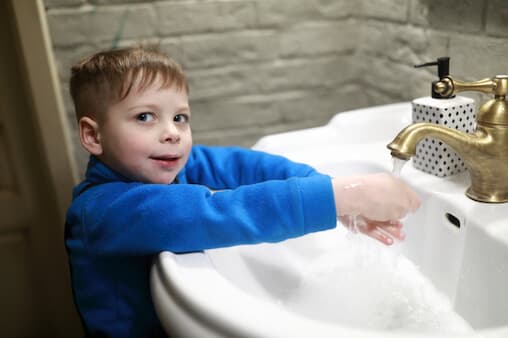6 Feet & A Mask: Hygiene Practice and COVID-19

Why 6 feet?
Viruses are an inert threat, incapable of replicating without a host cell in which to do so. They are essentially a microscopic package of RNA, wrapped in a membrane, only able to travel and reproduce by way of the host’s body. In the case of COVID-19, the most common way the virus is passed along is when an infected person coughs or breathes out, and millions of tiny water droplets carry the virus to its next destination. Recall a time your breath fogged a mirror. This is the visual evidence of usually-invisible water vapor leaving the lungs.
When a person breathes in, the air currents change around the face, creating a microcosmic vortex that draws air into the nose and mouth. Virus particles drawn into the digestive system have a low chance of survival, given that their final destination is most likely an acid bath in the stomach. If the coronavirus is drawn into the airways and lungs, however, it then attaches to the ACE-2 receptors present in the cells lining the airways and begins to replicate rapidly.
The water vapor that is expelled in exhalation can reach quite a distance, depending upon what a person is doing. Coughing expels the breath the farthest, typically to 6 feet – and sometimes more, while water droplets in the breath often reach 4-5 feet from singing and even up to 3 feet from talking. Maintaining a distance in public places reduces your chances of inadvertently breathing in another person’s recently exhaled virus.
To Mask or Not to Mask?
When the breath is exhaled at a natural, resting pace, most of the water vapor settles onto any surfaces within a three-foot semicircle in front of that person. This means that bathroom sinks, countertops, shopping carts, and any other objects within that range receive a light misting of water droplets, and any potential virus material presents therein. Because of this, masks do their best job when they are keeping the breath of a sick person contained, and unable to spread across the area around them. Depending upon the rating, masks do an okay job of keeping the virus out, but they are best at preventing us from spreading virus to others. And far better if both of us are wearing masks! And though it may seem straight forward, how you wear a mask makes a difference. Here’s a video with mask-wearing tips.
Homemade masks can be a great alternative if you can’t find any to buy, but it’s important that the material is effective at doing its job. A great way to test this is to hold any potential mask-making material over your face and see if you’re easily able to fog a mirror with your breath. If so, you may want to increase the layers, or try another material altogether. Another benefit of masks is their ability to increase humidity around the face. Studies have shown that coronavirus is less likely to survive in humidity between 40-60%.
The highly rated professional masks are marked “N-95,” meaning they filter 95% of air particles. A bandana, by contrast, might rate around “N-16.” Some of the best materials around the home for mask-making include clean vacuum bags, high thread count pillows (600+), and flannel. The most highly rated homemade masks so far have come from quilters, so layering a mask with batting may prove helpful if it’s handy. There are also many tutorials for how to make masks, including those for children, on YouTube.
Wash Your Hands, Sing a Song
While it’s always a good idea to wash your hands, it is especially important to do so in the face of a pandemic. Any time you’ve left the house, but especially if you’ve gone to the store, the post office, or any other space, wash your hands immediately afterwards. It has also been shown that coronavirus can spread through the stool, more so in children than adults, and thus hand washing is especially important after using the bathroom.
Hand sanitizer is helpful, or even isopropyl alcohol in a pinch, but using soap is the best option as it destroys the membrane around the virus, rendering it inactive.
It’s not only frequency, but also the quality of hand-washing that counts. In addition to lathering the palms, be sure to wash the backs of the hands, in between all the fingers, including the thumb, as well as the fingertips. A good washing should take at least 20 seconds and can be done as a sing-a-long to ensure enough time has passed, as well as making it more fun!
While these new social practices may be difficult or confusing for children, explaining to them that it’s doing a big part to keep everyone safe and healthy gives them a sense of purpose, and kids love to know they’re doing something be a part of the solution!
For more information on ways to take care of children during the spread of coronavirus, including ways to keep kids entertained, visit our Cold & Flu Health Center.


